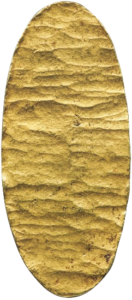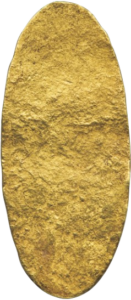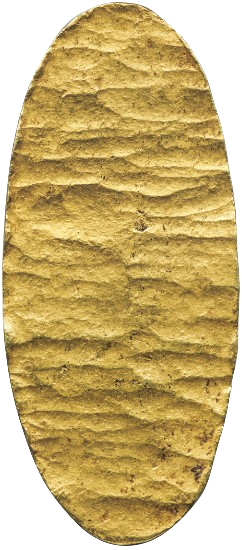Hirumokin (蛭藻金)


(Ginza Coins Collection, Tokyo. Reproduction authorized. © All rights reserved.)
Hirumokin represent a significant milestone in the history of Japanese coinage. Minted between 1501 and 1588, in a context of political transition and military instability, these gold coins owe their name to their resemblance to the leaves of the aquatic plant hirumo. Produced using advanced casting and engraving techniques, they were made by manually striking gold sheets on stone until the desired shape was achieved.
Simili alle più note Ōban ma di dimensioni inferiori e probabilmente di minor valore, le Hirumokin si caratterizzano per la forma allungata e la superficie liscia, talvolta incisa con simboli distintivi su richiesta di signori locali. L’assenza di standardizzazione è evidente nella variabilità di peso (fino a 140 grammi) e dimensioni (110 – 116 mm). Le informazioni rimangono scarse, contribuendo al mistero che le circonda.
In 1971, in Kōfu (Yamanashi Prefecture), an archaeological discovery yielded numerous specimens of Hirumokin and gold ingots, confirming their association with the region of Takeda Nobutomo, a central figure in the early stages of Japanese gold coinage.
A variant, the Karigane 雁金, (see image) features stylized engravings of the homonymous bird. One theory—lacking documentary confirmation—attributes its production to the Shibata clan, particularly to Shibata Katsuie, during his rule over Tsuruga (Echizen Province). The association with the family crest and the period of their rule supports this hypothesis, though the issue of the coin’s origin and actual use remains unresolved.
| Coin Name | Hirumokin |
| Japanese Inscription | 蛭藻金 |
| Historical Period | Sengoku Period (1467–1603 AD) |
| Year of Minting | 1501 – 1588 d.c. |
| Chronological Reference | Unspecified |
| Minting Location | Unspecified |
| Issuing Authority | Not definitively established |
| Function | Effective coinage (used for both commercial transactions and symbolic purposes, associated with local authority) |
| Material | Gold |
| Shape | Elongated |
| Altezza | 11 – 11.6 cm |
| Larghezza | 4.5- 5.2 cm |
| Weight | 115 – 140 g |
| Manufacturing Technique | Manually executed casting and striking performed on stone surfaces |
| Obverse Text and Symbols | At times featuring symbolic, non-standardized engravings |
| Reverse Text and Symbols | None |
| Calligrapher / Artist: | Unspecified |
| Museum References | Tokyo National Museum E-20082 Currency Museum Bank of Japan ⅡAカマb1/5 |
| Number of Known Specimens | A considerable number of specimens are known, although not quantified with precision; a particularly important discovery occurred in Kōfu in 1971 |
References and Bibliography
The Gold of Tokugawa, Alberto Rolfini 2025
Yamada Hagaki and the History of Paper Currency in Japan 1996
瀧澤武雄, 貨幣 Takizawa Takeo, Kahei Nipponshi sho Hyakka 1999

